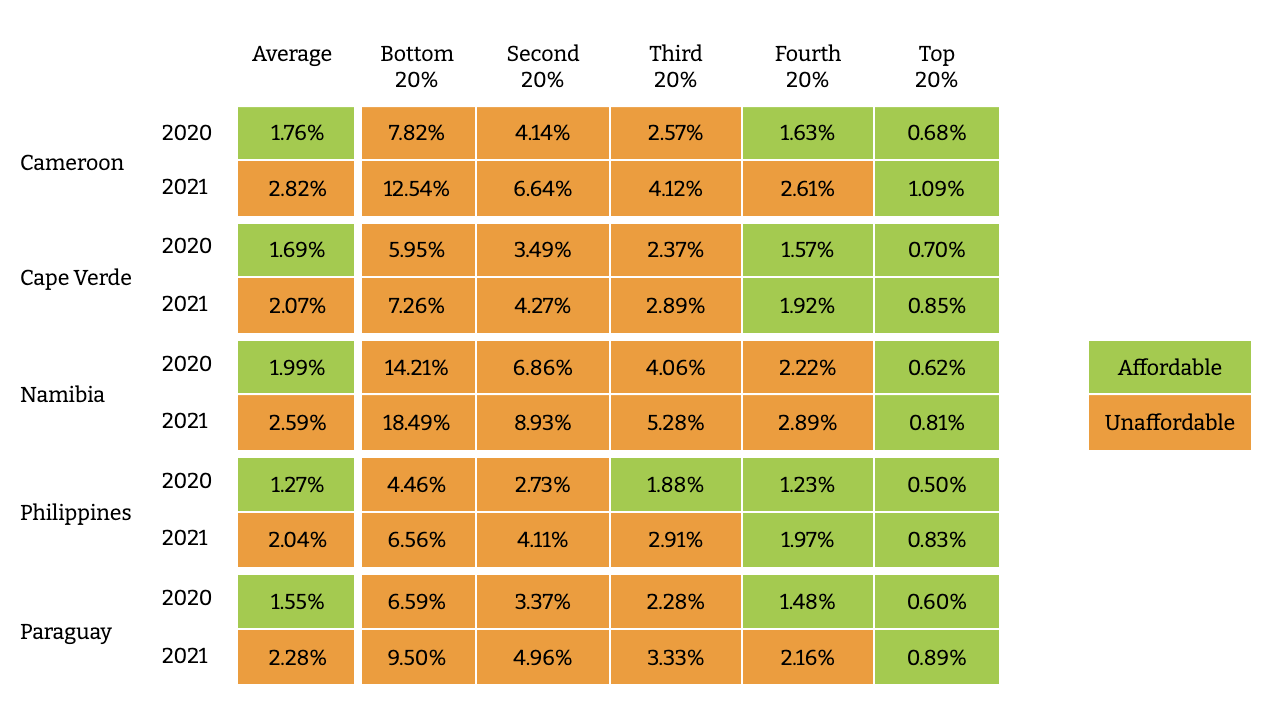This article was written by Ana Maria Rodriguez, Research Analyst and Teddy Woodhouse, Senior Research Manager for Access and Affordability.
According to an analysis conducted by the Alliance for Affordable Internet (A4AI), 1GB of mobile broadband data became less affordable in 2021 than the previous year.
Between 2020 and 2021, the median cost of 1GB of data as a percentage of average monthly income increased 13% in the 93 countries studied by A4AI in both years. This increase in cost represents a setback towards achieving the ‘1 for 2’ target for internet affordability – defined as 1GB for no more than 2% of average monthly income – and had significant consequences for people who greatly needed internet access during the Covid-19 pandemic.
The economic crisis triggered by Covid-19 reduced gross national income in many countries around the world. This reduced the affordability of 1GB of mobile broadband in 2021. Affordability is expressed as the price of data as a share of gross national income. In 2021, the change in income outweighed the price change. Suddenly, customers in low and middle income countries had less income available, making the prices less affordable.
A4AI began collecting data on mobile broadband pricing in low- and middle-income countries in 2015. This data is used to track these countries’ progress towards providing affordable mobile data for everyone. In 2021, A4AI and ITU expanded their partnership and began to collect data for high-income countries and expanded their data collection efforts to include multiple price points in more than 200 markets. For consistency, only the 93 low- and middle-income countries that have previously been included in A4AI’s data collection effort were examined for this analysis.
Least Developed Countries saw the largest increase in cost
The economies that were hardest hit by worsening affordability levels were also the most fragile. Between 2020 and 2021, the cost in the Least Developed Countries (LDCs) increased by 12%. In comparison, the cost in low-income countries increased by 5% bringing the level of affordability to six times that of upper-middle-income countries.
Several LDCs, in particular, experienced major setbacks. In Haiti, the cost of 1GB mobile broadband data increased by more than five times from 3.4% of a person’s income in 2020 to up to 18.5% in 2021. In Afghanistan, the cost increased between 2020 and 2021 from 5.5% to 9.1%. In Liberia, where the consumers were already facing high costs in 2020 with an affordability of 8.7%, it increased to 11.3% in 2021.
Figure 1 – Mobile data affordability by region and income group | Source: Alliance for Affordable Internet (Made with Highcharts)
Fortunately, it was not all bad news. Africa, the region that was furthest away from meeting the ‘1 for 2’ target for internet affordability, saw the greatest improvement in cost amongst the regions studied by A4AI, falling from 4.4% to 3.3% between 2020 and 2021. Malawi experienced the greatest improvement in terms of affordability among African countries, with costs falling from 14% to 6.2% in 2021. The Democratic Republic of Congo, Madagascar, Sudan, and Ethiopia all experienced significant reductions in their 1GB mobile data costs.
A setback for approximately 75 million people
When prices become less affordable, consumers in different income brackets experience the effects differently. The World Bank’s income quintiles are used by A4AI to understand how people in different income brackets react to price changes.
Cameroon, Cape Verde, Namibia, the Philippines, and Paraguay all met the ‘1 for 2’ internet affordability target in 2020 but failed to meet it in 2021. The cost increase caused lower-income quintiles in several of these countries to face unaffordable data in 2021. In the Philippines in 2020 the third, fourth and top income quintiles had affordable data, but this changed in 2021 for the third quintile. In the Philippines, the price of 1GB of mobile broadband data went from being affordable to unaffordable for the third quintile, changing from 1.9% in 2020 to 2.9% in 2021. Similar changes occurred in Cameroon and Paraguay for the fourth income quintiles.
Due to the change in cost, in Ecuador, Lesotho, Mexico, Mauritius, El Salvador, and Tanzania, people in at least one income bracket were no longer offered affordable prices for 1GB of data in 2021. In 2021, 75 million more people in eleven low- and middle-income countries lost access to affordable 1GB mobile broadband data plans, however, none of the people affected were among the top income bracket.

Table 1 – Mobile data affordability by income quintiles | Source: Alliance for Affordable Internet
Going back in time to 2018 data affordability levels
In 2021, on average 1GB of mobile broadband data represented 2.6% of a person’s average monthly income indicating that costs have regressed to their pre-2019 affordability levels. The median affordability of the countries analyzed in 2018 was 3% but in 2019 it was lower than the current 2021 figure. This is bad news, made worse by the fact that people relied on the internet to access critical information, healthcare, and education services during the pandemic and the accompanying shutdowns.
ICT policymakers should learn from this crisis and prioritise making prices more affordable, especially during periods when internet access is critical for the public. ICT policies should help keep data affordable even when incomes shrink. Lastly, policymakers must commit to longer term efforts aimed at lowering data costs over the long run to prevent short term progress being wiped out by future price increases. Research such as the Affordability Report and A4AI’s Good Practices Database offer initial steps forward.
